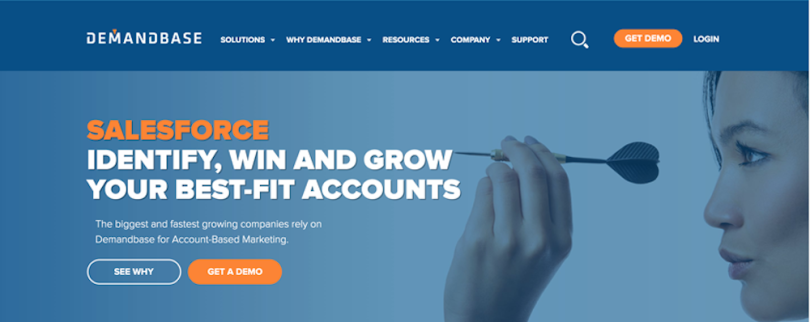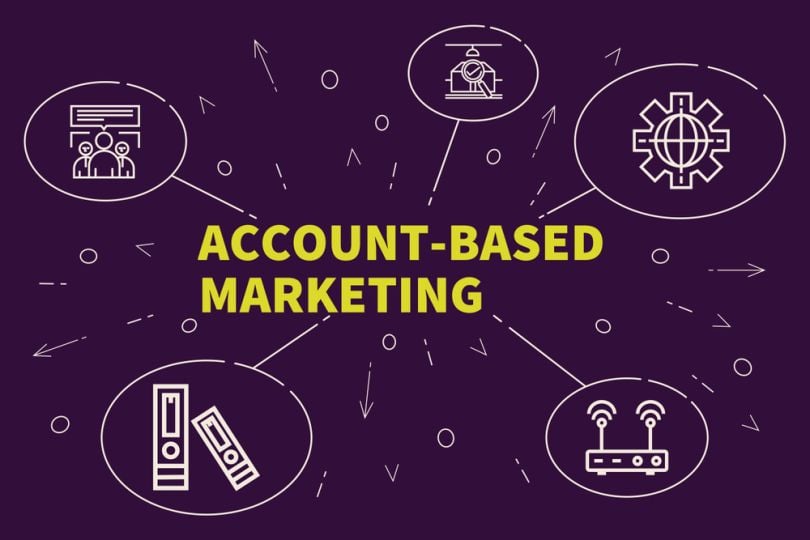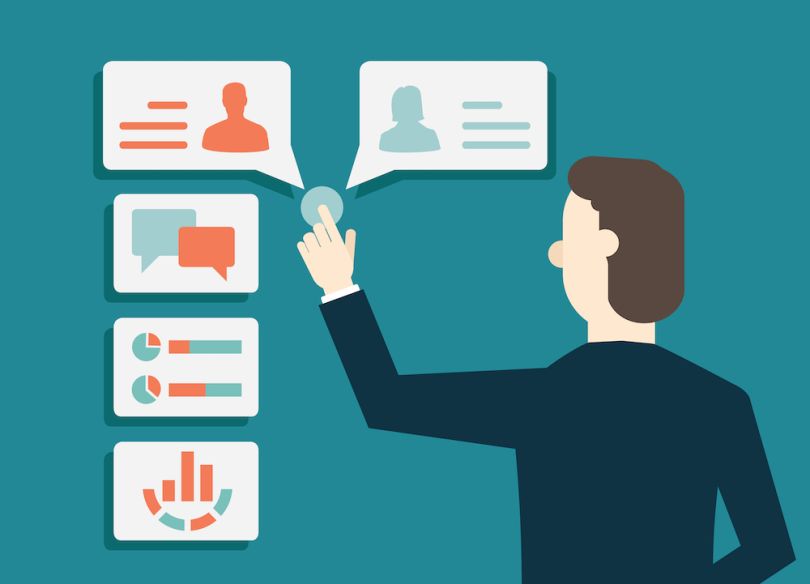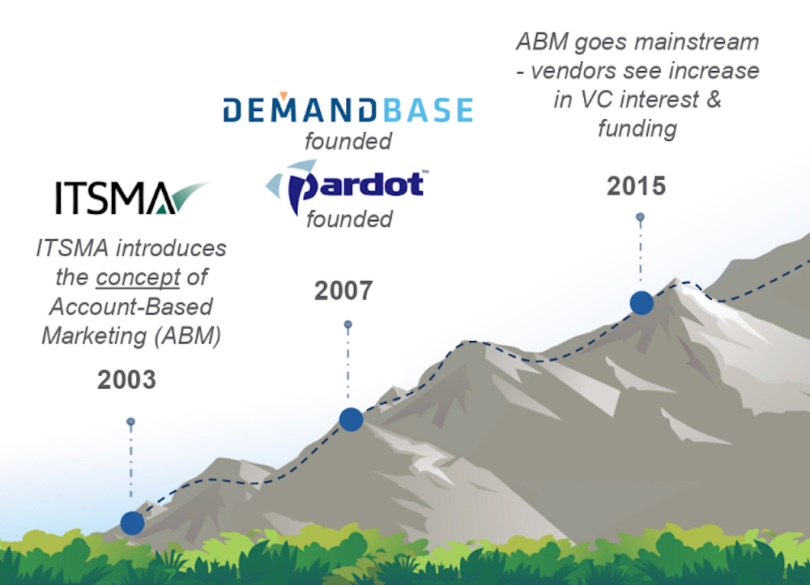Anyone can visit the Demandbase website, but not everyone who does sees what Nate Skinner sees.
Most people initially encounter the image of a woman, lips pursed, holding a dart that’s aimed at an offscreen target. Orange and white lettering spells out the promise-command, “B2B marketers, identify, win and grow your best-fit accounts.”
While Skinner views an almost identical page, “B2B marketers” is replaced with “Salesforce,” Skinner's employer and one of DemandBase’s biggest clients. It’s a perfect illustration of what account-based marketing (ABM) is all about: creating targeted, personalized marketing experiences for stakeholders on key accounts.

Website personalization is one aspect of this strategy and among Demandbase’s signature services. The company’s AI-enabled platform parses which users work where based on IP address, and tweaks a website’s front end accordingly.
“You as a human being want to be spoken to,” Skinner told Built In. “We are more likely to engage with a brand that actually talks to us like it knows who we are.” (Data backs him on this: a personalized website boosts sales an average of 19 percent; personalized marketing emails have 41 percent higher clickthrough rates.)
As a marketer himself, though, Demandbase’s website also sparked some healthy competitiveness in Skinner. When he first saw the automated Salesforce shoutout, he thought, we need that functionality on the Salesforce website.
No longer. Today, Salesforce is a Demandbase client, and personalizes its homepage for key visitors — including Demandbase leadership. They see a custom message on Salesforce’s homepage, similar to what Skinner sees on Demandbase's homepage.
There’s something futuristically sweet about it: two multi-million dollar companies, making each other feel special through automated personalization. It’s an institutional love story. It’s also a case study in ABM.

What is account-based marketing?
Engagio CEO Jon Miller wrote the e-book on ABM. In it, he defined ABM as “a go-to-market strategy that coordinates personalized marketing and sales efforts to land and expand high value accounts.”
Less technically, Miller told Built In, it’s akin to “fishing with spears.”
What is Account-Based Marketing?
Using a net would be the equivalent of traditional broad-based marketing, which aims to attract as much attention as possible through outbound strategies (cold-calling, paid TV advertising, anything that feels like an interruption) and inbound marketing (content marketing, webinars, anything that attracts an organic audience). All that attention tapers down into “1,000 hand raisers,” Skinner said, “that turn into 10 deals.”
Many of those who initially pay attention, though, won’t be in the target audience. (That’s especially true for B2B marketing campaigns.) Grabbing their attention, then, is a waste of marketing power, and a waste of their time. The message, for them, is irrelevant — one of the many bits of needless information clogging their inboxes and brains.
Marketers often refer to this unnecessary communication as “noise.” There’s a lot of it out there, Skinner said.
“You get just bombarded as a professional, as a consumer and as a business person, with messages that are all over the place.”
ABM can cut through the noise without adding to it. It's a B2B marketing strategy that boosts campaigns’ relevance by focusing all that broad-based marketing energy on hand-picked prospective and existing accounts that can plausibly buy what’s for sale.
Those key accounts receive personalized attention through different types of marketing efforts. These could include a custom web experience, a content marketing campaign or even direct mail outreach. ABM isn’t an inbound or outbound approach — every marketing tactic can fall under the ABM umbrella, Miller said, as long as marketing and sales work together in “lockstep" to target specific accounts.
Ideally, product teams also get in on the synergy. Mike Burton, co-founder of Bombora, said ABM is a bit of a misnomer. He prefers “account-based go-to-market” (as does Miller in his e-book), or the more expansive “account-based everything.” ABM, Burton argued, is about more than marketing. Top-tier clients should be front of mind when the product team conceptualizes new features and offerings, he said — not just when sales and marketing sells them.

How does account-based marketing work?
The theory sounds great, but how does a company identify its top-tier clients? Skinner calls this ABM 101, and it breaks down into a couple of sub-questions.
What prospective accounts would be most valuable? A company needs strategic ways to identify and approach potential high-value clients. Engagio’s marketing analytics help companies identify and prioritize “hot accounts” and map out their “territory” (a.k.a., all their possible accounts). Salesforce, meanwhile, has an AI layer in its customer relationship management software (CRM). Dubbed Einstein, this layer identifies prospective accounts that holistically similar to a company’s existing ones.
By finding data-driven similarities between accounts based on region, sector and contact information, it “helps you understand questions you didn’t even know to ask,” Skinner said.
Which existing accounts are the most valuable? Traditional marketing often focuses on new accounts, but existing accounts also need to be nurtured and expanded. That’s where a CRM comes in handy. Salesforce’s provides a sortable directory of a company’s clients. In the SaaS interface, a B2B enterprise can sift through its existing accounts based on attributes like size and sector, or more nuanced metrics like frequency of contact or the company’s current interest in buying a product. (Read on.)
Which prospective and existing accounts actively want your product? Or, in industry terms, which companies have shown "intent"? This is surprisingly measurable. Bombora, for instance, quantifies intent with a sophisticated data pipeline that's aggregated from a mix of B2B media sources. These include publishers like Haymarket Media, lead generation companies that track whitepaper downloads and webinar signups, plus a smattering of actual vendors. (Like most technology, Bombora integrates with Saleseforce, whose app exchange Skinner calls “the world’s largest business app store.”)
“Marketers already have a really good idea of their [target account] list,” said Bombora’s Burton. “Our job is to tell them the subset of that list that's most interested right now.”
Intent can help ensure relevant messaging, but intent alone can’t support a business.
“The fraction of your target audience that's actively actually researching your category at any given time is pretty low,” Engagio’s Miller warned.
Once a company selects its target accounts, the next step is creating a personalization strategy, which Skinner calls ABM 102. The key to this more complex, case-by-case process is automation, which makes ABM possible at scale. Currently, it's possible through Demandbase, Salesforce’s Pardot and Engagio’s platform.
But automation wasn’t always so easy.

Where did account-based marketing come from?
Skinner attempted his first ABM campaign in 2003. He wasn’t yet employed by Salesforce, and his client, a software company, didn’t use the term “ABM.” Instead, the sales lead spoke of “diamond accounts.”
“He was looking at our quarterly forecast and the most important opportunities we had were from our largest customers,” Skinner explained. “[He wanted to] do events that are specific to [those diamond accounts] and do ads and send emails that were specific to them.”
Back then, the height of automated personalization was… mail merging. It wasn’t really up to the task, so Skinner manually wrote emails to stakeholders at each account.
“I remember thinking, ‘I wish we could do this [regularly], but it’s almost impossible,’” he said of the one-off project.
That same year, 2003, Beverley Burgess coined the term “account-based marketing” in a paper for Information Technology Services Marketing Association. (At the time, she was ITSMA’s European vice president.) Her original definition of ABM — “treating individual accounts as markets in their own right” — was meant to unite sales and marketing strategy to get companies both “share of revenue” and “share of mind” on key accounts, she told Built In.
Back then, Miller recalled, he saw ABM as a strategy for multi-million dollar accounts only — in other words, it was only for major corporations serving major corporations. Early-aughts personalization was too expensive to make sense for a smaller transactions.
Soon enough, though, technology started to make ABM more affordable. Looking back, Skinner characterized 2007 as a “gold rush of marketing technology” during which both Demandbase and Pardot (a B2B marketing automation platform) were founded. (Salesforce acquired Pardot in 2013; Skinner is vice president of Pardot product marketing.)
These new technologies could track and leverage customer data more autonomously than any tools that had come before — but they couldn't quite mainstream ABM, which has only begun to make sense at a large scale in the last five years. Miller traces the shift to a second ABM tech boom in 2015. That year, he realized that ABM required its own toolkit — that he couldn’t spearfish with a net — and set out to build one. He left his inbound marketing company Marketo. He wasn’t alone: Another ABM company, Terminus, opened that same year. Engagio and Terminus collaborated on some marketing efforts, and Google searches for “account-based marketing” and “ABM” climbed.
ABM is now a $1.19 billion global industry, and it offers far more sophisticated personalization than “Hello [NAME]” at the beginning of an email. (No offense, mail merge.) For decision-makers at big accounts, the marketing experience had become an elaborate, automated choose-your-own-adventure story.
A downloaded white paper, a webinar — every action, and every possible sequence of actions, had a unique marketing outcome, Skinner explained. That's a strategic achievement and a tech breakthrough.

What technology does account-based marketing rely on?
Technology has changed how individuals shop — you can browse 15,000 reviews before buying a bar of soap — and it's shifted how institutions shop, too. Once upon a time, companies made purchasing decisions based on conversations with sales representatives. There was no need for services that tracked “intent,” because companies declared their intentions openly.
“[They] might do a little bit of online research here and there, but the vendors themselves were at the table,” Burton said.
Online research and reviews now dominate the B2B buying process. Companies rarely engage with sales reps unless they know they want to place an order. In a way, ABM is a reaction to technology and digital reviews — an attempt by vendors to regain a seat at the (now-virtual) table where purchasing decisions get made. However, the following new technologies also make ABM possible.
Lead-to-account matching: Enterprises receive constant streams of engagement data via web traffic, email, CRM and marketing platforms. Not all of it, though, is clearly linked to an account, which can make it difficult to measure the impact of an ABM strategy. Lead-to-account matching addresses this issue by automatically sorting internal data into account-based buckets.
It seems easy enough. “Look at the email address, right? If it says, @salesforce.com, pretty good guess they work at Salesforce,” Miller said.
Sometimes, however, someone’s work email isn’t available or doesn’t offer enough information. Miller gave an example: “If somebody has a ge.com email address, you don't know which division of GE they’re part of; then you have to look at their geography. And if you find out that they're in New York, at that point you'd make a pretty good guess that they're a part of GE findings.”
Lead-to-account matching handles all these complexities.
Account-based targeting tools. Marketers have long been able to target niche populations, like “people who search Amazon for cauliflower pizza crust,” but their toolkit has only recently grown refined enough to target leads on specific accounts. (It’s easier to figure out what people search on Amazon than who makes buying decisions at Amazon.) LinkedIn’s API, for instance, and the IP address tracking that Demandbase relies on both enable account-specific outbound marketing efforts.
Sales engagement tools: Miller said technologies like SalesLoft and Outreach are essential to scalable ABM. “There’s not anything specifically account-based about those tools,” he explained, “but they're very much about fishing with the spear.”
Both tools were essentially designed to simplify Skinner’s Sisyphean ABM project of 2003. They're mail merge, on steroids. These tools allow marketers to send template-based, personalized sales emails to stakeholders at major accounts. “[The email] comes from [the author] as opposed to looking like a marketing email,” Miller explained. “Then if the [recipient] doesn't respond, it can do the appropriate follow-up.”
In other words, they offer a combination of automated personalization and automated persistence.

Where is account-based marketing headed?
Despite its newly powerful tech infrastructure, ABM isn’t exactly poised to dominate.
“Very few companies do account-based marketing instead of everything else,” Skinner said. “They do account-based marketing as an augmentation to everything else. It's an additive strategy.”
It shouldn’t be underestimated, though. ABM prompts higher engagement than broad-based marketing and can bring in higher returns.
The next step, Burton said, is more serious adoption. At this point, people know the phrase “account-based marketing,” and plenty of companies dabble in it. Still, returning to Skinner's metaphor of ABM as an academic course sequence — 101, 102, etc. — few companies operate at the 103 level or beyond. That’s where Demandbase’s website customization lives alongside lead-tracking chatbots and many other sophisticated apps.
“Only 10 or 15 percent of the market is doing [ABM] well at scale,” Burton said.
He thinks that number will grow.
“The tech and the data is ahead of the reality of execution. We could use a couple of years of just kind of hunkering down and using what we have.”
Miller sees ABM technology evolving, too, though. At this point, ABM platforms like Engagio are walled off from inbound marketing platforms like Marketo and Hubspot, but he suspects that’s temporary.
“People aren't going to want to buy two different platforms,” Miller said. “I think… you'll start to see a kind of convergence.”
That could mean ABM and broad-base marketing platforms acquiring each other, or just building out their offerings to accommodate multiple marketing strategies. (Miller plans to do the latter at Engagio.)
On a cultural level, the rise of ABM will ideally make marketing less of a noisy and toxic presence in buyers' lives. On Bombora’s website, the two metaphors of noise and toxicity are bound together. “Noise” is cast a kind of communicative pollution, and ABM is presented as its opposite: “sustainable marketing.”
The dynamic between marketers and their audiences can certainly feel unsustainable. By one estimate, almost half of consumers use ad blockers. Inbound marketing, or content marketing — a way of circumnavigating ad blockers — is losing speed. SEO optimization, a pillar of inbound, has grown increasingly difficult.
Ten years ago, “if I wanted to rank for a keyword, all I had to do was write a blog post about that topic and we'd probably show up on page one [of the search results] for that topic,” Miller said. “Now it's almost impossible to get on page one for anything.”
One day, perhaps, ABM will feel unsustainable too. As it becomes more widely adopted, it could simply concentrate today's "noise" in the inboxes of a few key decision-makers. For now, though, ABM emphasizes strategizing more and doing less, edging us closer to a world where B2B marketing feels like a sustainable part of the communications ecosystem — and occasionally makes us say, as Skinner did when he first saw his personalized Demandbase landing page, “pretty cool.”
Images via Shutterstock, social media and company websites.




